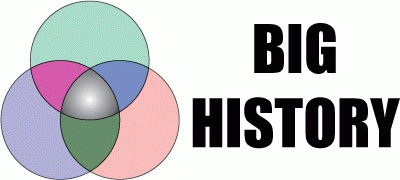Big History by Steve Consilvio
It is better to recognize that ideas rule the world, not men, because men can change what they believe, but ideas themselves are unchangeable. Ideas exist in their own separate and pure state, and we give them life by accepting them. We are both observers and participants in an epic clash of ideas.
A Venn diagram is represented by overlapping circles: one black, the other white, and the overlap is grey. The combination generally represents a "sweet spot' of balance, but it can also be the source of dissonance. The circles themselves can represent opposite or complimentary things. Each circle is extreme, one-dimensional, or pure, depending upon your perspective. The overlap implies integration. The yin-yang symbol represents a similar concept, and the belief that ideas and power are constantly shifting. The only thing that does not change is change.
The Big History model is a Venn diagram using three circles stacked to form a pyramid. Each circle overlaps on two of its sides, which forms three unique combinations. There is a fourth area, in the center, where all three circles overlap.
The circles represent three types of ideas: religious, political and economic. These topics correspond to our human experience: abstract, social and physical. This trinity repeats often: our brain, our heart and our hands, or, our thoughts, feelings and actions. All of human existence falls into these three categories.
Ideas form our perception. The ideas of any one person are a group of ideas, just as an economic transaction is a group or chain of transactions. There are always connections between the one and the many. This model helps to explain why people understand the same data differently.

Categories by Steve Consilvio
Where two ideas overlap, the empires of government, business and churches (non-profits) have formed. The balance they represent is achieved by excluding the remaining category of thought. This indicates that each empire is uniquely incomplete. The empires are non-political (Business), non-religious (Government) and non-profit (Churches). For example, Economics + Religion = Business, and excludes Politics.
Within these empires of Church, State, and Business are many individual organizations. They exist to satisfy our needs, and are formed based upon a combination of secondary ideas. People who agree on one set of ideas form an entity, and those who disagree form a separate entity. Intellectually, the separation of Church and State and Business is a completely natural event, and mimics the division of labor and the separate parts of ourselves. Our three main institutions reflect specialization.
However, we exist as individuals separate from the main categories, empires, and organizations. Our primary unit is the family. In the model, we occupy the center, and need to balance with everything and everyone. We struggle amongst contradictory perceptions and purpose. The center reflects why and how dissonance becomes part of the human experience. It is not healthy for individuals or organizations to be working at cross-purposes. All men want balance between the one and the many. We have inadvertently institutionalized perpetual conflict.

Big History Detail by Steve Consilvio
The Big History labels should not be taken too literally. The Religion realm and Church empire includes atheism, humanism and secular organizations. Whether or not God exists is an abstract question, so it falls under the abstract theory category. Similarly, both socialism and capitalism fall under economics. They are theories about how to best organize the physical world. All ideas fit into a category type. The purpose of the model is to explore how categories of thought interact with one another.
Change can be represented by shifting the discs towards the center, or by layering the discs in a different order. The ascendency of one category of thought can exert an influence on other categories and organizations. For example, when politics rises in importance, there are political changes. The democratic ideals that challenged monarchial government marked the ascendency of political theories.
Next Page 1 | 2 | 3 | 4 | 5 | 6 | 7 | 8
(Note: You can view every article as one long page if you sign up as an Advocate Member, or higher).






